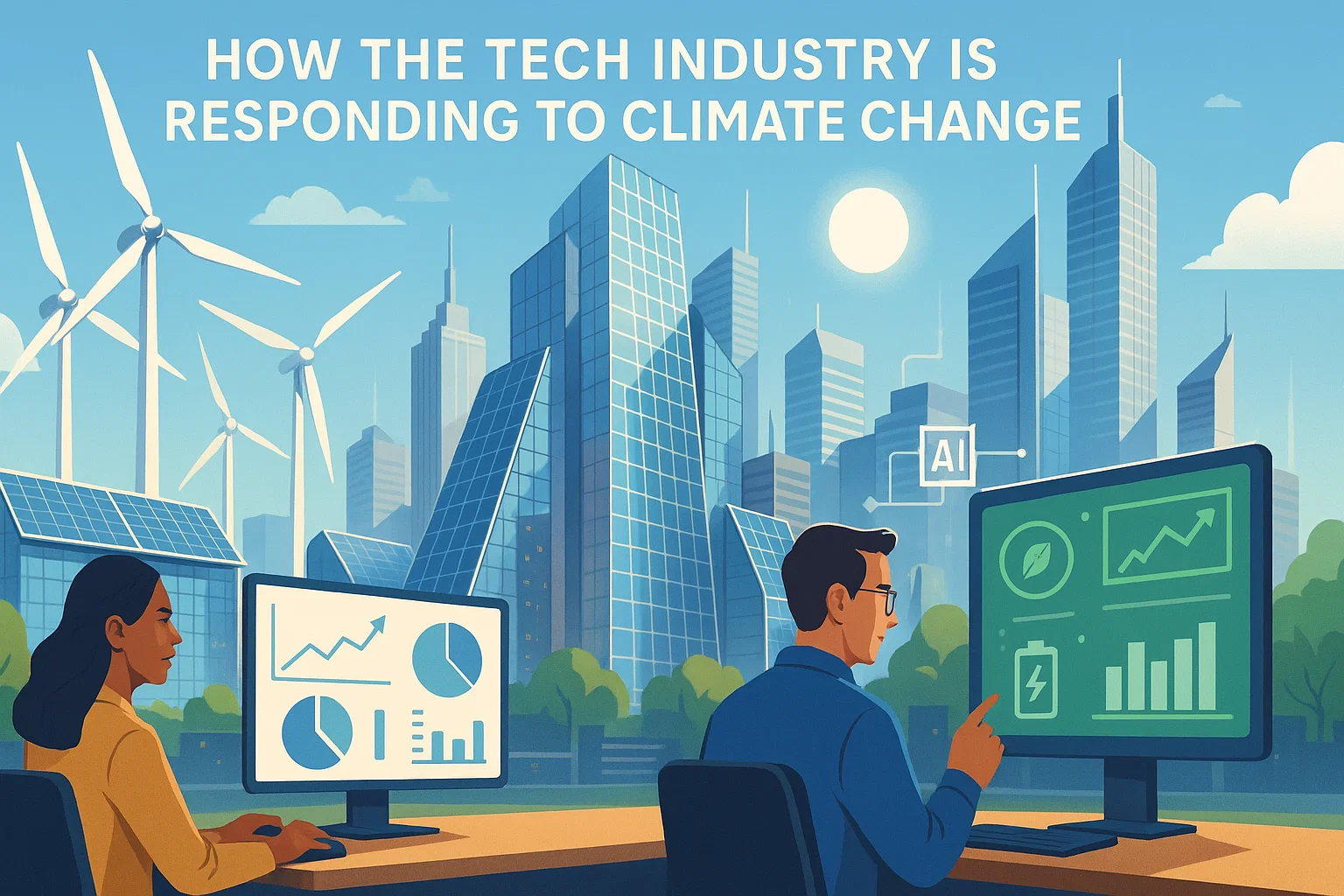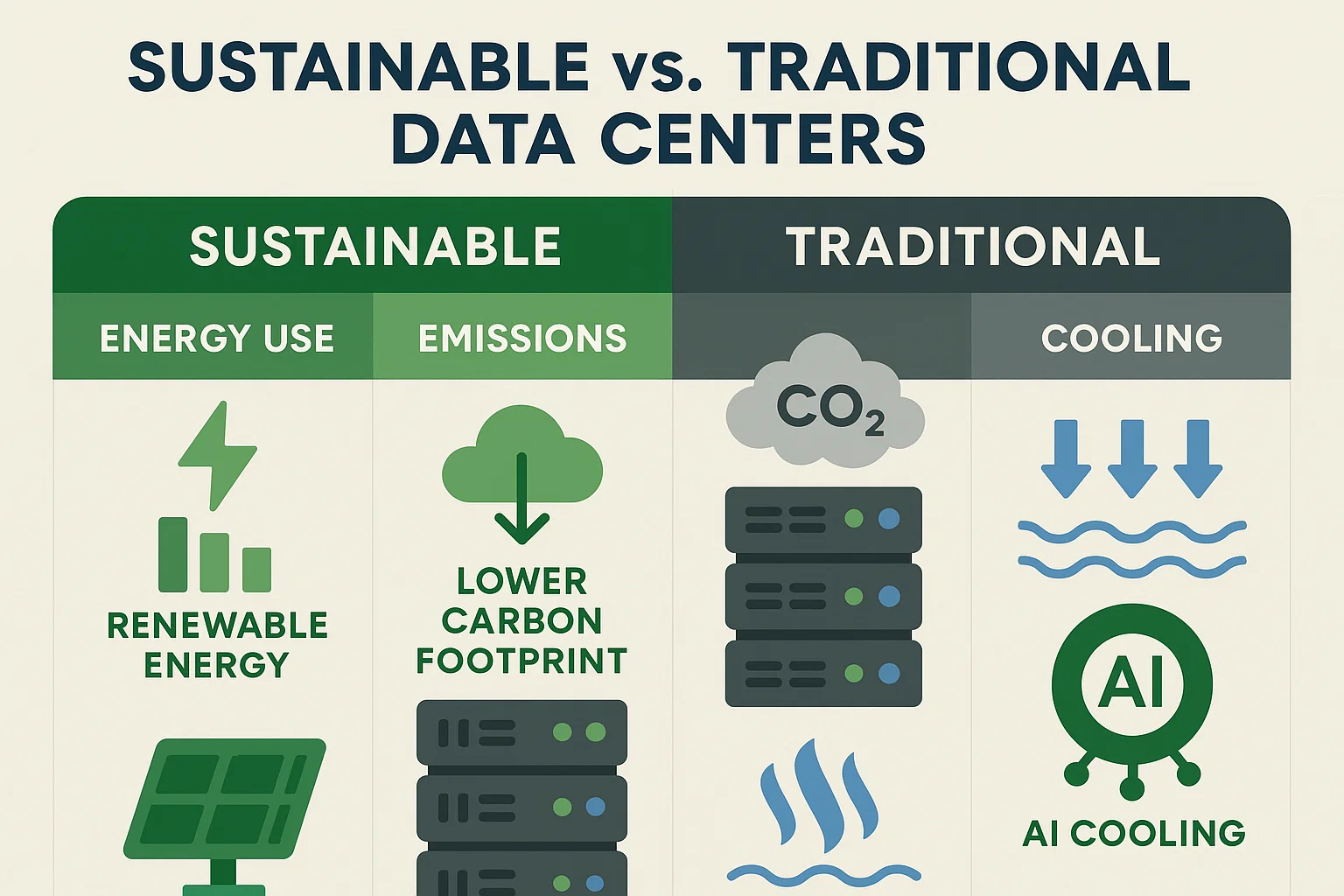 Every year, the world sets new temperature records and new tech records. From AI breakthroughs to global cloud expansions, innovation races ahead. But so does our planet’s warming. According to NASA’s 2024 climate data, global surface temperatures are now about 1.4°C higher than in preindustrial times, and tech’s own energy footprint is growing fast.
Every year, the world sets new temperature records and new tech records. From AI breakthroughs to global cloud expansions, innovation races ahead. But so does our planet’s warming. According to NASA’s 2024 climate data, global surface temperatures are now about 1.4°C higher than in preindustrial times, and tech’s own energy footprint is growing fast.
By 2030, data centers alone could consume nearly 8% of the world’s electricity, if efficiency measures stall. Yet, paradoxically, these same technologies AI, IoT, and cloud systems hold some of our most powerful tools to fight the crisis.
This tension defines the modern era: can the very engines of innovation also cool the planet they helped heat?
For the first time, the world’s biggest technology companies are treating that question as a moral and operational imperative. From AI-driven weather modeling to zero-emission chip factories, tech is reshaping climate response not as charity, but as core strategy.
(Visual cue: a hero image here showing a futuristic city powered by renewables and monitored by AI sustainability systems.)
From Carbon to Code How Tech Is Helping the Planet
The turning point came when data met the environment. The industry realized it could do what it does best measure, predict, and optimize and apply those strengths to the natural world.
AI and Machine Learning for Climate Prediction
Artificial Intelligence has become a force multiplier for climate research. AI-driven systems now process terabytes of satellite and sensor data daily to model everything from rainfall patterns to wildfire spread.
For example, Google’s DeepMind developed AI models that improve short-term weather forecasts by up to 89% accuracy, helping communities prepare for floods or storms. Meanwhile, IBM’s Green Horizon Project uses AI to monitor air pollution in cities like Beijing, allowing for real-time policy adjustments that have visibly improved air quality.
AI is also driving “climate twin” simulations digital replicas of Earth that allow researchers to test different environmental interventions virtually. This means scientists can model reforestation or carbon removal techniques before applying them in the real world.
(Infographic idea: global AI systems improving prediction accuracy across continents.)
IoT and Smart Infrastructure
The Internet of Things (IoT) has turned our cities and factories into living, breathing data systems. Sensors in streets, pipelines, and buildings now report temperature, energy use, and air quality around the clock.
In Singapore’s Smart Nation program, IoT sensors help reduce urban heat by managing traffic, optimizing lighting, and even rerouting public transport during smog alerts. In the U.S., Los Angeles uses connected streetlights that dim automatically when roads are empty, saving millions in energy costs and cutting carbon emissions.
These “smart infrastructures” don’t just monitor they act. For example, smart grids balance renewable energy inputs (like wind and solar) in real time, stabilizing power delivery. It’s a quiet but powerful shift: code replacing carbon.
Cloud Computing and Sustainable Data Centers
Cloud computing once a major culprit of emissions has rapidly evolved into one of the greenest segments of tech. The world’s largest cloud providers are racing to make operations 100% powered by renewable energy.
- Microsoft plans to be carbon negative by 2030, meaning it will remove more carbon than it emits.
- Google Cloud now runs on carbon-free energy 24/7 in select regions, aided by AI energy management systems.
- Amazon Web Services (AWS) is building wind and solar farms across 15 countries to offset its enormous energy use.
Even edge computing, which brings processing closer to users, reduces energy waste by minimizing data transport distances.

Tech Companies Taking Action
What was once “corporate social responsibility” has become an existential business strategy. The question isn’t if tech companies should respond to climate change it’s how quickly.
Corporate Climate Commitments
The biggest names in tech are now leading climate pledges that outpace even national commitments.
- Apple: Carbon neutral for corporate operations since 2020, now pushing suppliers to follow. Their recycling robot, Daisy, can recover rare earth materials from 1.2 million iPhones a year.
- Tesla: Not just selling electric vehicles but reshaping the global energy grid through battery storage and solar systems.
- Google: On track for 24/7 carbon-free operations across all data centers by 2030 a world-first for a company of its size.
- Intel and TSMC: Developing low-carbon semiconductor manufacturing and investing in circular water reuse systems.
These actions aren’t just PR they’re competitive advantages. Sustainability now attracts investors, partners, and consumers in equal measure.
Green Manufacturing and Hardware Recycling
Electronics manufacturing used to be one of the dirtiest parts of the supply chain. Toxic chemicals, heavy metals, and enormous water usage defined the process. That’s changing fast.
The rise of circular electronics where devices are designed to be disassembled and reused is reducing e-waste. For instance, Fairphone, a Dutch startup, builds smartphones using conflict-free materials and easily replaceable parts. Larger firms like Dell and HP have introduced take-back programs that recycle old machines into new components.
In 2024, global e-waste reached nearly 60 million metric tons. By improving materials recovery, the tech sector could offset millions of tons of CO₂ annually.

Tech for Adaptation and Resilience
Not all climate tech is about prevention; much of it’s about helping humanity adapt.
Drones and Satellite Monitoring
When wildfires rage or ice sheets crack, drones and satellites become humanity’s eyes in the sky. Planet Labs operates over 200 mini-satellites that image the entire Earth daily, providing real-time environmental intelligence.
Drones, too, are stepping up. In Africa, solar-powered drones monitor illegal logging and wildlife migration patterns. During disasters, they deliver supplies and assess damage when roads are impassable.
These technologies don’t stop climate change, but they help societies survive and rebuild smarter.
Water and Energy Optimization Tech
Clean water scarcity is one of the greatest threats of a warming planet. AI-powered irrigation systems are revolutionizing agriculture in drought-prone areas.
Companies like CropX and John Deere use soil sensors and satellite data to fine-tune watering schedules, saving billions of gallons annually. In energy, microgrids local, self-contained power systems keep hospitals and schools running during outages while cutting fossil fuel reliance.
The Challenges Ahead
The irony of climate technology is that it’s not carbon-free itself. Manufacturing servers, batteries, and sensors still produces emissions. Bitcoin mining alone emits more carbon annually than some small nations.
Even as AI optimizes climate prediction, training large models requires staggering energy. One GPT-scale model can emit 300,000 kg of CO₂ roughly the same as 125 round-trip flights between New York and London.
Then there’s ethical complexity. Who controls the climate data? How transparent are algorithms that guide global policy? As governments rely more on AI insights, the risk of bias or error can have planetary consequences.
Tech must balance progress with responsibility. As the industry races forward, self-regulation and open collaboration will decide whether innovation helps or harms.
Future Innovations That Could Change Everything
The next generation of climate solutions may look like science fiction but many are already in development.
Quantum Computing for Climate Simulations
Quantum processors can analyze data sets far too complex for today’s supercomputers. The European Quantum Climate Initiative (EQCI) is using this power to simulate atmospheric chemistry at atomic scales, potentially revealing new ways to neutralize carbon.
Biodegradable Electronics
The dream of electronics that safely decompose after use is becoming reality. Researchers at Stanford and Seoul National University have built circuits made from natural polymers that dissolve without leaving toxins. Imagine IoT sensors that vanish after collecting years of environmental data no landfill required.
Carbon Capture Nanotech and Smart Materials
Nanomaterials are being designed to pull carbon directly from the air. Climeworks, operating in Iceland, already uses giant fans and chemical filters to remove CO₂ permanently from the atmosphere. The next step? Embedding that ability into everyday materials paint, concrete, even clothing.
Expert Insights and Predictions
According to Gartner’s 2025 Tech and Sustainability Outlook, over 75% of global tech firms now link executive bonuses to climate targets. The International Energy Agency (IEA) reports that tech-led innovation could cut up to 30% of global emissions by 2050 if scaled properly.
Maria Gonzalez notes:
“The climate fight won’t be won by one invention. It will be won by how we connect inventions AI predicting droughts, IoT monitoring energy, and humans choosing to act on the data. Technology is the language of change; we just need the will to speak it consistently.”
Practical Checklist for Businesses
For small companies, sustainability doesn’t require billion-dollar budgets. It starts with practical digital habits:
| Action | How Technology Helps | Climate Benefit |
|---|---|---|
| Move to cloud services with renewable commitments | Use Google Cloud, Microsoft Azure, or AWS sustainability dashboards | Cuts server electricity by up to 70% |
| Audit energy use with smart meters | IoT devices track usage in real time | Reduces waste and cost |
| Encourage remote work | Use secure VPNs and virtual collaboration tools | Lowers daily commuting emissions |
| Implement paperless workflows | Use e-signature and document systems | Prevents unnecessary paper production |
| Partner with e-waste recyclers | Certified recyclers handle old tech | Prevents toxic landfill waste |
(Infographic idea: “5 Simple Ways Small Businesses Can Go Green with Tech”)
Final Thoughts Before You Try It Yourself
Climate change isn’t a distant storm it’s the background noise of every industry now. But in that challenge lies opportunity.
The tech world has already proven it can rewrite how we live, learn, and connect. Now it’s writing a new story how we survive. Every student learning code, every startup optimizing logistics, every engineer designing cleaner chips contributes to that story.
The fight against climate change isn’t just happening in labs or boardrooms. It’s happening in every line of code, every efficient router, every recycled smartphone.
Technology is no longer just about faster or smarter. It’s about lasting.
And in that sense, the best innovation isn’t the next big thing it’s the next sustainable one.